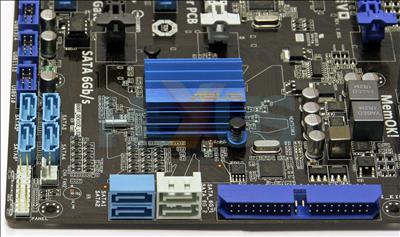What to expect
The IDE is run off a Marvell controller that also supports SATA 6Gb/s - double the standard speed - and we like the fact that the ports are rotated for easy connectivity. However, we're not so impressed by the location of the other four SATA ports; they should be on the edge of the board.
The blue-coloured ports run off the southbridge and support RAID0,1,5, and 10 modes via Intel's Storage Matrix Technology.
Power and reset buttons are always welcome, and there's basic on-board troubleshooting via debug LEDs, dubbed Q-LED. The board has the usual features, sporting FireWire, dual Gigabit LAN, and eight-channel HD audio, courtesy of VIA and Realtek controllers.
Graphics-wise, you might as well ignore the third x16 PCIe mechanical slot. The CPU provides 16 lanes that will be spit either two x8 or a single x16.
Notice the 2oz copper markings on the PCB? Following on from previous designs, ASUS is sandwiching the copper in the PCB, to help with heat dissipation. Here it's differentiated by having the copper interspersed between the PCB's layers.
The rear is pretty standard for a modern motherboard, taking in two Gigabit LAN ports and two forms of S/PDIF. A clear CMOS button is also handy, especially if your case is a pain to get into.
Summary
The introduction of newer Nehalem-based processors will herald the release of a raft of supporting chipsets to house the LGA1155/1156 chips. The ASUS P7P55D EVO constitutes a typical example of what to expect from a mid-to-high-end P55 motherboard. Overall layout is good, if not perfect, and we should expect to see it retail for less than X58 boards.
However, recent price-cuts to X58 motherboards has seen the price plummet to around £130, suggesting significant overlap between it and forthcoming P55. What Intel will need to do is to price LGA1156 at sensible levels, probably below £150, to entice buyers to the new platform.
ASUS, though, is ready to launch boards as soon as Intel gives a green light. We successfully benchmarked an LGA1156 chip and it's a shame that we can't publish numbers; they make for some very interesting reading.
















